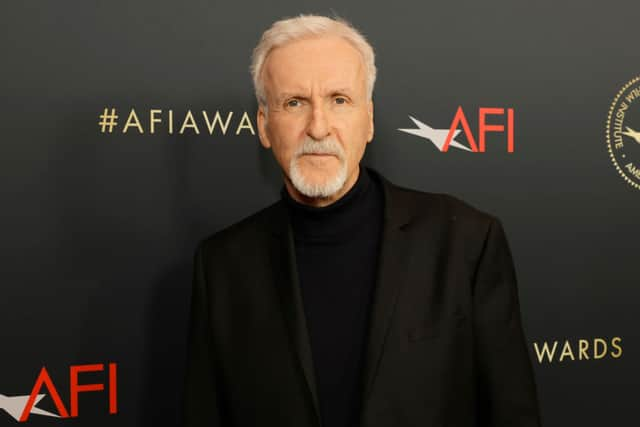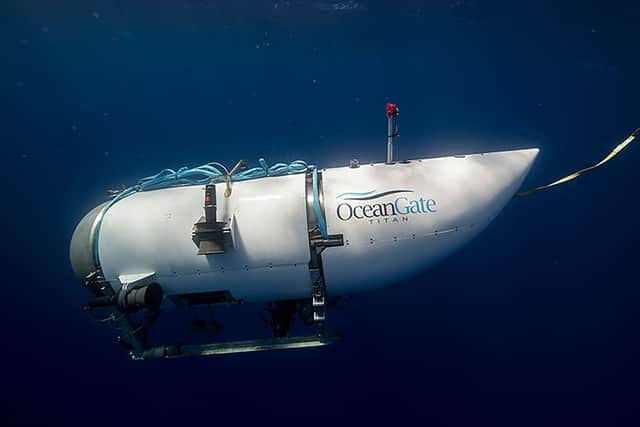James Cameron: Titanic director says he predicted fate of Titan submarine
and live on Freeview channel 276
Titanic director and submersible expert James Cameron said he predicted Titan’s fate days before the debris from the missing submersible was found. Those on board Titan included OceanGate chief executive Stockton Rush, along with UK citizens Hamish Harding, Shahzada Dawood and his 19-year-old son Suleman Dawood and French national Paul-Henri Nargeolet.
OceanGate announced on Thursday (22 June) that the pilot and four passengers of the missing Titan submersible were believed to be dead. The tail cone was found around 1,600ft from the bow of the Titanic, which sank in the North Atlantic Ocean in 1912.
Advertisement
Hide AdAdvertisement
Hide AdRear Admiral John Mauger said further debris was also found, in the North Atlantic Ocean off the coast of Newfoundland, that was “consistent with a catastrophic loss of the pressure chamber”.
What did James Cameron say?
Speaking to the BBC, Cameron said he predicted the outcome of the ill-fated submersible days before the news was confirmed.
“I felt in my bones what had happened,” Cameron said. “For the sub’s electronics to fail and its communication system to fail, and its tracking transponder to fail simultaneously – sub’s gone.
“I knew that sub was sitting exactly underneath its last known depth and position. That’s exactly where they found it.”
Advertisement
Hide AdAdvertisement
Hide AdHe added: “[It] felt like a prolonged and nightmarish charade where people are running around talking about banging noises and talking about oxygen and all this other stuff. I immediately got on the phone to some of my contacts in the deep submersible community. Within about an hour I had the following facts. They were on descent. They were at 3500 metres, heading for the bottom at 3800 metres.
“We now have another wreck that is based on unfortunately the same principles of not heeding warnings.”


Cameron also spoke to ABC News about submersible engineering following the news regarding the OceanGate Expeditions craft.
He said: “This is a mature art and many people in the community were very concerned about the sub.
Advertisement
Hide AdAdvertisement
Hide Ad“A number of the top players in the deep submergence engineering community even wrote letters to the company, saying that what they were doing was too experimental to carry passengers and they needed to be certified.
“So I’m struck by the similarity of the Titanic disaster itself, where the captain was repeatedly warned about ice ahead of his ship, and yet he steamed at full speed into an ice field on a moonless night and many people died as a result.
“For a very similar tragedy where warnings went unheeded to take place at the same exact site, with all the diving that’s going on all around the world – I think it’s just astonishing.”
Cameron said the loss of Paul-Henri Nargeolet, who he described as a “legendary submersible dive pilot” and a friend of 25 years, was “surreal”.
Advertisement
Hide AdAdvertisement
Hide Ad“For him to have died tragically in this way is almost impossible for me to process,” the director said.
What happened to the submersible?
Cameron’s comments come as the US Navy said they heard a sound consistent with an implosion when communications were lost.
The US Navy went back and analysed its acoustic data and found an anomaly that was “consistent with an implosion or explosion in the general vicinity of where the Titan submersible was operating when communications were lost”, a senior Navy official told The Associated Press on Thursday (22 June).
The official spoke on condition of anonymity to discuss a sensitive acoustic detection system.
Advertisement
Hide AdAdvertisement
Hide AdThe Navy passed on that information to the Coast Guard, which continued its search because the Navy did not consider the data to be definitive.
The US Coast Guard confirmed the tail cone of the deep-sea vessel was discovered around 1,600 ft from the bow of the Titanic wreckage during a press conference in Boston.
Rear Admiral John Mauger said further debris was also found, in the North Atlantic Ocean off the coast of Newfoundland, that was “consistent with a catastrophic loss of the pressure chamber”.


When asked about the safety of the Titan submersible, former Royal Navy submarine captain Ryan Ramsey explained that lessons need to be learned and questions need to be answered.
Advertisement
Hide AdAdvertisement
Hide AdHe said: “That’s the question that needs to be answered. Most submersibles and all submarines go through a stringent safety process. Every time they come back in and every time before they go to sea they do safety checks, check the safety of the hull, state of the hull openings, everything.
“What’s apparent here is they didn’t have to follow the same regulation, and therefore didn’t follow the same regulation. I think that will be where a big focus is. That doesn’t mean blame, that’s not what we should be doing, what we should be doing is what’s called adjust culture, where we work out lessons learned and implement them going forward.”
Comment Guidelines
National World encourages reader discussion on our stories. User feedback, insights and back-and-forth exchanges add a rich layer of context to reporting. Please review our Community Guidelines before commenting.
